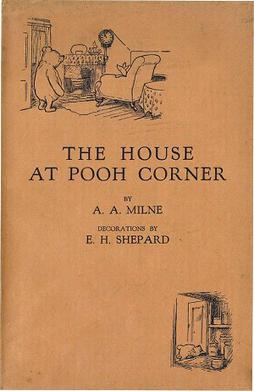The House at Pooh Corner facts for kids

First edition
|
|
| Author | A. A. Milne |
|---|---|
| Illustrator | E. H. Shepard |
| Country | United Kingdom |
| Language | English |
| Genre | Children's novel |
| Publisher | Methuen & Co. Ltd. (London) |
|
Publication date
|
1928 |
| Media type | Print (hardback & paperback) |
| Preceded by | Winnie-the-Pooh |
The House at Pooh Corner is a classic children's book. It was written by A. A. Milne and illustrated by E. H. Shepard. This book, published in 1928, is the second collection of stories about the famous bear, Winnie the Pooh. It's special because it introduces a new, bouncy character: Tigger.
Contents
What's the Story About?
The book's title comes from a story where Winnie the Pooh and Piglet build a house for their friend Eeyore. Another fun part is when the game of Poohsticks is invented. This is a game where sticks are dropped into a river from one side of a bridge. The players then race to the other side to see whose stick appears first.
Like the first Pooh book, most chapters are separate stories. You can read them on their own. However, Chapters 8 and 9 go together. In these chapters, the friends look for a new home for Owl. His old house was blown down in a storm.
Throughout the book, there are hints that Christopher Robin is growing up. This becomes very clear in the last chapter. The animals of the Hundred Acre Wood throw him a farewell party. They have learned that Christopher Robin must leave them soon. It's not said directly, but it's clear he is starting school.
In the end, everyone says goodbye to Christopher Robin. Pooh and Christopher Robin climb a hill. They share a long, private goodbye. Pooh promises he will never forget his friend. The book closes with a sweet thought. It says that no matter where they go, a little boy and his Bear will always be playing in that special place.
Chapters in the Book
Here are the titles of the stories you'll find in The House at Pooh Corner:
- In Which a House is Built for Eeyore
- In Which Tigger Comes to the Forest and Has Breakfast
- In Which a Search Is Organized, and Piglet Nearly Meets the Heffalump Again
- In Which It Is Shown That Tiggers Don't Climb Trees
- In Which Rabbit Has a Busy Day, and We Learn What Christopher Robin Does in the Mornings
- In Which Pooh Invents a New Game and Eeyore Joins In
- In Which Tigger Is Unbounced
- In Which Piglet Does a Very Grand Thing
- In Which Eeyore Finds the Owlery and Owl Moves Into It
- In Which Christopher Robin and Pooh Come to an Enchanted Place, and We Leave Them There
Pooh Corner on Screen and Stage
The House at Pooh Corner has been adapted many times. The stories have been turned into audio recordings, songs, and animated films.
Audio Stories
In 1960, a dramatized version of two chapters was recorded. It featured famous voices like Sterling Holloway as Pooh. Later, in 1988, Alan Bennett narrated an audio version. In 1997, Walt Disney released another audio dramatization. It featured voices like Jim Cummings as Pooh and Tigger.
Songs Inspired by Pooh
In 1971, singer-songwriter Kenny Loggins released a popular song. It was called "House at Pooh Corner." The song talks about the loss of childhood innocence. It also shares a feeling of missing simpler, happier times.
Loggins re-released the song in 1994 as "Return to Pooh Corner." This version included a new verse. It was about an adult Christopher Robin giving Pooh to his own son. This verse shows Christopher Robin's happiness. He feels like he has finally come back to Pooh Corner.
Animated Adventures
Many parts of the book have been made into Disney animated films.
- Chapters 2, 8, and 9 were used in Winnie the Pooh and the Blustery Day.
- Chapters 4 and 7 became Winnie the Pooh and Tigger Too!.
- Chapter 6 was adapted in Winnie the Pooh and a Day for Eeyore.
- The final chapter was used in The Many Adventures of Winnie the Pooh. It was also seen in Pooh's Grand Adventure: The Search for Christopher Robin. In the book, Christopher Robin goes to boarding school. In the films, he just goes to school and comes home later.
- Chapters 1 and 3 were used in parts of Piglet's Big Movie.
Live-Action Film
The 2018 live-action movie Christopher Robin is like an unofficial sequel to the book. The film shows a grown-up Christopher Robin. He meets Pooh again for the first time since going to boarding school. The movie's first scenes are based on the last chapter of the book.

